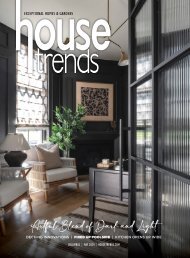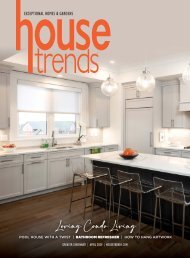Dayton Idea Book February 2023
Create successful ePaper yourself
Turn your PDF publications into a flip-book with our unique Google optimized e-Paper software.
WHAT TYPE OF BULB SHOULD I GET?<br />
Picture a basic lightbulb. You know, the small one with the wires you<br />
can see that you’re used to sticking in your table lamps. That’s an incandescent<br />
lightbulb. Tried and true, it’s the base model of lightbulbs and<br />
provides the gold standard of light.<br />
The American Lighting Association (ALA) names three additional types of<br />
lightbulbs to choose from:<br />
Halogen incandescent<br />
CFL (Compact fluorescent)<br />
• Halogen incandescent – This bulb is very similar to the traditional<br />
incandescent bulb, as it’s part of the same incandescent family, but is<br />
more efficient than its traditional counterpart, using up to 30 percent<br />
less energy.<br />
• CFL (Compact Fluorescent) - The CFL bulb is more efficient still than<br />
the halogen incandescent, using up to 75 percent less energy than the<br />
traditional incandescent lightbulb, but its use is expected to decline due<br />
to the growing popularity of LEDs.<br />
• LED - Today, the LED bulb is the most efficient, longest lasting, and<br />
often the most suitable type of bulb for home lighting. The new models<br />
look very similar to traditional bulbs. These bulbs tend to have a slightly<br />
higher upfront cost, given their energy efficiency, but that cost is mitigated<br />
by their very long life.<br />
Now that we can identify the different bulbs, we can continue with<br />
other criteria to use in selecting the right bulb for you.<br />
WHAT SHOULD I LOOK FOR IN A LIGHTBULB?<br />
When you look at a box of lightbulbs, you will see a series of numbers<br />
along the bottom. Believe it or not, all these numbers actually mean<br />
something, and understanding them will greatly help you choose the right<br />
bulb!<br />
The next time you pick up a pack of lightbulbs, check the box for the<br />
following:<br />
• Lumens: How bright is the bulb?<br />
• Color: Is the light from the bulb a warm 2700K or a cool 4000K?<br />
• CRI: Does the bulb render colors beautifully? 80+ is good, 90+ is great!<br />
• Dimmable: Can I use the bulb with a dimmer switch?<br />
LED<br />
WHAT’S A LUMEN?<br />
Traditionally, lightbulbs were measured using wattage, which measures<br />
the amount of energy a lightbulb uses. But this is not an entirely accurate<br />
unit of measurement now, especially since bulbs take up less energy than<br />
ever before. For example, an 80W lightbulb does not inherently mean<br />
double the amount of light as a 40W lightbulb.<br />
Instead, we should use lumen, which measures a bulb’s brightness. For<br />
space lighting, anywhere from 450 to 1,600 lumens could do the trick, but<br />
for cozy, reading lighting, you would probably look for less brightness, and<br />
therefore, less lumens. It all depends on your space. ➻<br />
54 housetrends.com

















